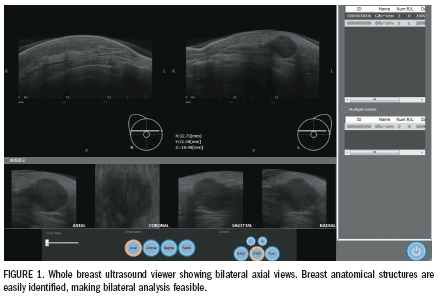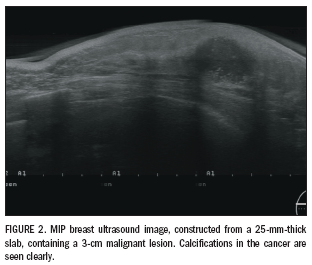Whole-breast ultrasound brings significant screening benefits
Breast cancer is one of the leading causes of cancer death among women. The risk of breast cancer typically increases with age in most countries.
Breast cancer is one of the leading causes of cancer death among women. The risk of breast cancer typically increases with age in most countries. The chief exception is Japan, where the incidence of breast cancer increases in women aged 30 to 50 years old, peaks at the age of 50, and then declines.1
Early detection can improve cancer survival and simplify patients’ treatment. This has led to the introduction of screening programs in many countries so that signs of breast cancer can be detected at an early stage.
Mammography is currently used routinely in population based screening programs to check for signs of breast cancer in women aged 50 years and older. The technique is relatively simple, cost-effective, and has been shown to reduce mortality by more than 20%. Some studies show a reduction in mortality of up to 30% or even 40%.2-5

The sensitivity of mammography is, however, lower in younger women and in Asian women. Women in these groups tend to have dense breasts, but inherent limitations in mammography limit its ability to depict masses in dense breast tissue. This poses a significant problem to breast screening programs in Japan. Not only do Japanese women tend to have dense breast tissue, but the incidence of breast cancer is also higher in younger Japanese women, particularly those in the 40- to 49-year-old age group. This has prompted manufacturers and government authorities to seek out a more suitable imaging modality, or combination of modalities, to deliver breast care in Japan.
Interest in breast ultrasound has increased steadily and it is now considered a valuable adjunct to mammography. Ultrasound is effective at imaging soft tissues in the body, using the transmission and reflection of sound waves. The modality does not rely on x-ray absorption differences to generate detail in images and so its ability to depict masses is not limited by dense breast tissue.
Ultrasound imaging has suffered in the past from poor image quality, limited detail recognition, and low spatial resolution. Advances in ultrasound technology have allowed remarkable improvements in image quality and the modality has been greatly enhanced. High-resolution ultrasound can now provide an excellent, real-time depiction of anatomic details in the breast.

The use of ultrasound in characterizing breast masses was traditionally limited to differentiating fluid-filled cysts from solid masses, an important but limited role in breast cancer detection and diagnosis. Additional roles for the modality are now being developed, thanks to improvements in breast ultrasound technology. These roles include breast assessments for younger women, women who have less fatty breasts, women who are undergoing hormone replacement therapy, women who have breast implants, and Asian women.
This expansion in the role of ultrasound has prompted the development of whole-breast ultrasound systems. Such systems generate images that depict the entire breast, unlike conventional images that show only small regions.
Breast ultrasound ex- aminations are typically performed by clinicians or sonographers using a small handheld probe (typically 4 cm across). Examination times vary significantly according to the size of the breast and its fat composition. An examination will typically take 15 to 20 minutes in Japan, and up to 45 minutes in Western countries. Most of the time, both breasts are examined in Japan; this examination time assumes bilateral examination.
Although freehand breast ultrasound is a valuable tool for breast cancer detection and diagnosis in the hands of experienced clinicians, results are highly operator-dependent. Some regions of the breast may be missed from the scan altogether, raising the risk that a cancer could go undetected. The reproducibility of freehand ultrasound images is also poor. Images acquired have a limited field-of-view (typically 5 x 5 cm) and do not provide full-field images of the breast. This suggests that freehand ultrasound is not sufficient for whole-breast ultrasound imaging.
WHOLE-BREAST IMAGING
One example of a dedicated whole-breast ultrasound scanner is the Automated Whole Breast Ultrasound Scanner ASU- 1004 by Aloka. The device was developed specifically for breast cancer screening in Japan to address the issues outlined above.6

The device comprises a water tank and a 7.5-MHz, 6-cm linear transducer submerged in the water. The breast is positioned on top of a membrane stretching over the water tank and enclosing the water, and a scan is taken from below by the underwater probe. Original scans are acquired in the axial plane, with the probe running in three overlapping sweeps and covering a scan field of 16 x 16 cm.
Patients undergoing conventional breast ultrasound imaging are often positioned while lying on an examination bed. This patient preparation procedure can be a factor in the throughput rate in a screening environment. The positioning procedure used with the ASU-1004 scanner is quite different. The patient stands up and bends forward, as if she were taking a Japanese bow. She then lowers one of her breasts onto the scanner, adopting a modified prone position.7
Data from the three sweeps are “stitched” together using software developed at Gifu University in Gifu, Japan. Any breast cancers can then be detected and evaluated from the resulting volumetric data (Figure 1). This whole-breast imaging data can be displayed in axial, sagittal, and coronal form, though the original (axial) scanning plane will have the highest resolution.
The size of images generated (axial view) is 694 x 400 pixels with a resolution of 0.23 mm/pixel and 256 gray-scale levels. A unilateral breast study with a slice-to-slice interval of 2 mm will contain 84 (axial) images. Image acquisition time is 20 seconds. On decreasing the slice interval to 1 mm, 0.5 mm, or 0.25 mm, the number of images will increase to 168, 336, and 672, respectively, and the acquisition time to 40 sec, 80 sec, and 160 sec, respectively.
VOLUMETRIC ANALYSIS
The depiction of calcifications has widely been considered a challenge for breast ultrasound. The volumetric data produced by whole-breast ultrasound imaging is helping to redress this (Figure 2). The identification of anatomical structures means that corresponding breast regions can be registered, leading to the feasibility of bilateral and/or temporal analysis. This is important if the breasts are to be analyzed systematically. Clinicians’ assessments of abnormalities and estimations of their extent are greatly assisted by the manipulation and presentation of data in three orthogonal views and reslicing of the volumetric data (Figure 3).
Clinical imaging diagnoses are moving steadily toward multiplane and multimodality protocols. Visual comparisons of images from different modalities must consequently be performed. Whole-breast ultrasound makes it possible to identify a lesion’s location relative to surrounding breast tissue. Ultrasound images can also be compared (and registered) with images from other modalities, such as mammography and MRI (Figure 4).8
The ability of whole-breast ultrasound to distinguish between benign and malignant lesions has been reported. Preliminary studies based on the ASU- 1004 volumetric whole-breast ultrasound data show that the diagnostic value of the data is not lower than that of conventional handheld ultrasound. Specifically, the sensitivity in discriminating benign and malignant masses is over 92%.9,10
The vast amount of data generated by volumetric imaging and the high throughput rate in mass screening programs suggest that computer-aided detection (CAD) could be of use. Cancers could otherwise be missed by radiologists who are fatigued after viewing large numbers of disease-free cases. CAD systems can also act as a second opinion or second pair of eyes.
Although most breast CAD systems are designed to work with mammography, some have also been developed specifically for whole-breast ultrasound data. Research in this area is focusing on the automated detection and classification of breast masses, and the identification of different mammary gland patterns.9-13
LOOKING AHEAD
Breast ultrasound will take on a more substantial role in breast cancer detection and diagnosis as ultrasound technology continues to develop. The availability of information on the whole breast, similar to that available from mammography, is an important step in this direction. Whole-breast images can be essential when interpreting complex cases, such as patients presenting with benign lesions that also have invasive elements, and when diagnosing subtle lesions.
The quality and resolution of wholebreast ultrasound images will continue to improve as the technology develops. For instance, the elimination of artifacts, such as lateral shadowing and shadowing behind the nipple, will improve the accuracy of ultrasound for diagnosing cancer. It is hoped that whole-breast ultrasound will bring benefits to breast cancer screening programs for Asian women.
What New Research Reveals About Novice Use of AI-Guided Cardiac Ultrasound
April 4th 2025In a study recently presented at the American College of Cardiology (ACC) conference, researchers found that novice use of AI-guided cardiac ultrasound after an AI-enabled electrocardiogram increased the positive predictive value for reduced left ventricular ejection fraction (LVEF) or aortic valve stenosis by 33 percent.
New AI-Enabled Portable Ultrasound May Facilitate 50 Percent Reduction in Cardiac Imaging Scan Time
March 28th 2025Artificial intelligence (AI)-powered measurement capabilities provide key features with the Compact Ultrasound 5500CV device, which was unveiled at the American College of Cardiology (ACC) conference.
AI-Initiated Recalls After Screening Mammography Demonstrate Higher PPV for Breast Cancer
March 18th 2025While recalls initiated by one of two reviewing radiologists after screening mammography were nearly 10 percent higher than recalls initiated by an AI software, the AI-initiated recalls had an 85 percent higher positive predictive value for breast cancer, according to a new study.